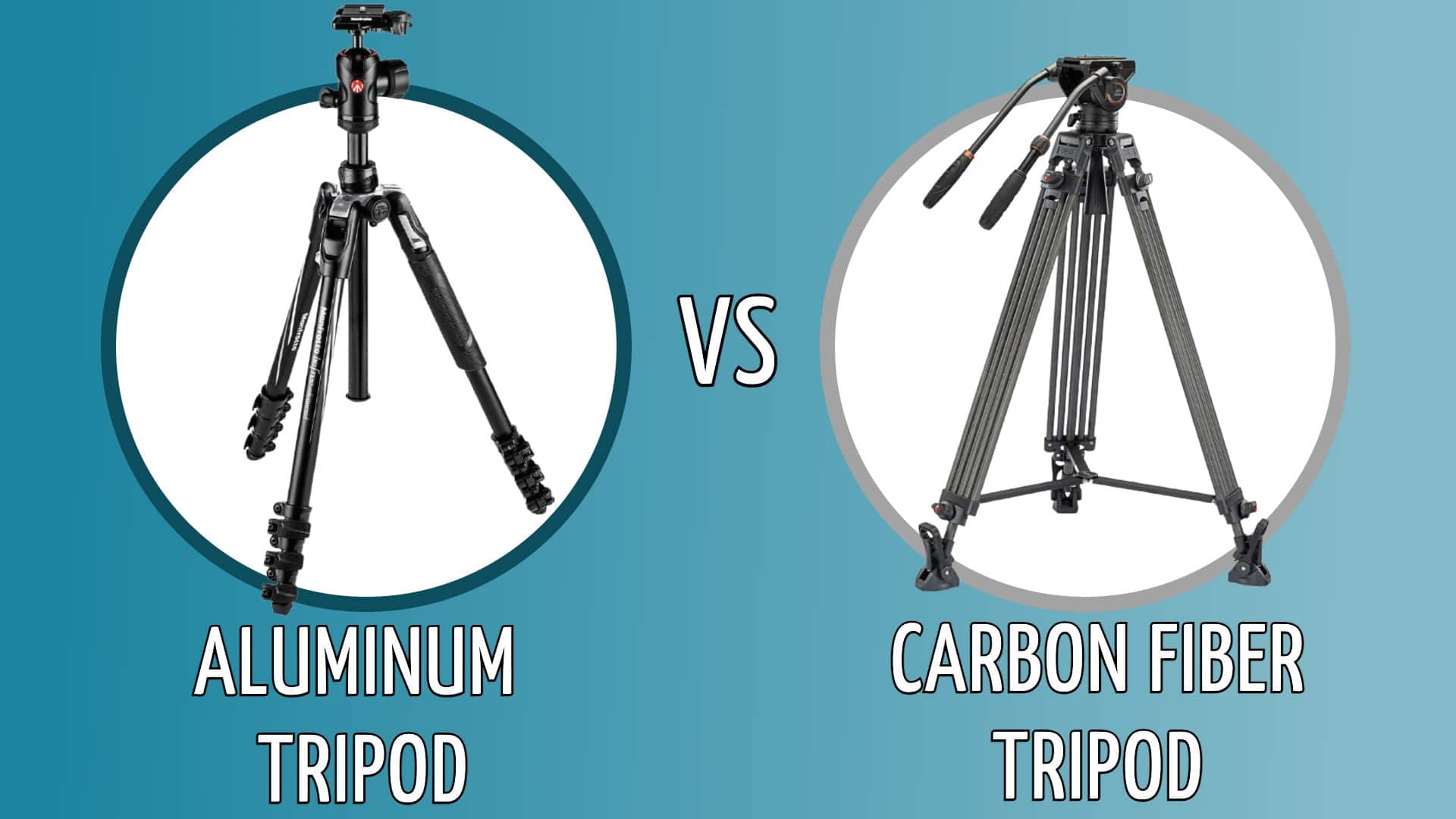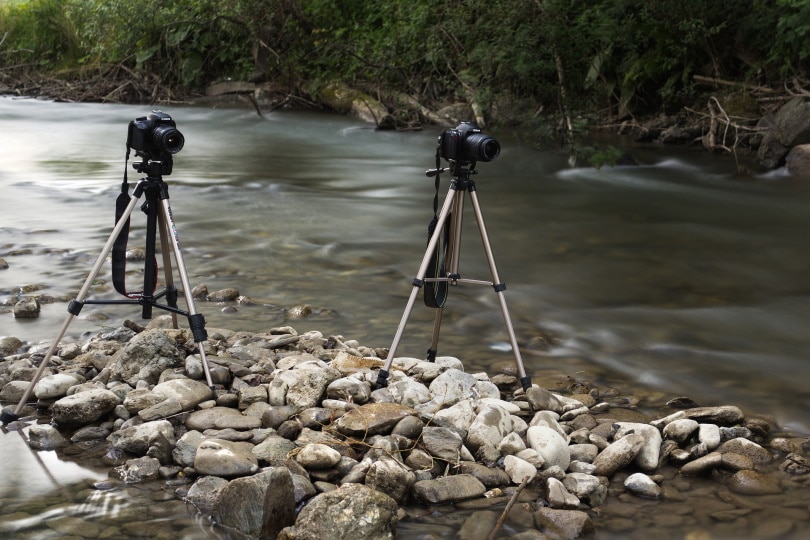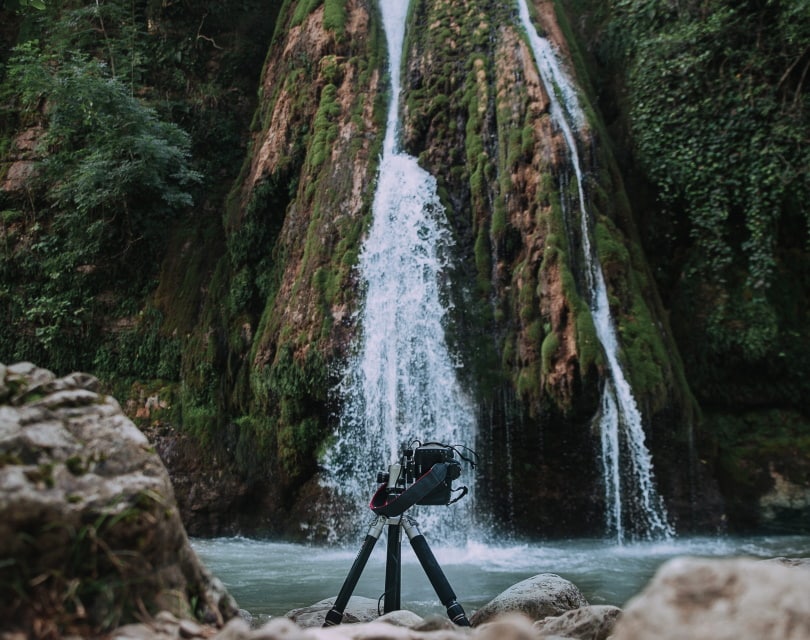Aluminum vs. Carbon Fiber Tripod: Which Is Better?
Last Updated on

While you might not think that the construction of your tripod is a huge deal, the more you get into photography or spotting, the more you’ll realize that it’s one of the most important decisions you can make.
But what’s the difference between an aluminum tripod and a carbon fiber one? More importantly, which one do you need? We break down everything that you need to know to make your decision.

Overview of Aluminum Tripods
Aluminum tripods are the most common out there, and it’s not hard to see why. They have a slew of advantages that make them excellent choices for a wide array of applications.
Advantages of Aluminum Tripods

By far, the most significant advantage of an aluminum tripod is the price. Aluminum tripods are among the most affordable available, and it’s a significant reason that their popularity has surged. Not everyone needs the best of the best of everything, and sometimes you just want something that can get the job done.
But those who go with an aluminum tripod get a secondary perk: It’s more stable than its carbon fiber counterpart. This is because aluminum tripods weigh more. While this can be a disadvantage in some situations, it’s much harder for wind and other natural elements to move them.
Disadvantages of Aluminum Tripods
If the entire purpose of a tripod is to provide a stable base for your camera and they’re more affordable, why would you go with anything else? The truth is that while aluminum tripods are excellent choices, they aren’t the best at everything.
For starters, they are heavier than carbon fiber tripods. While this might be an advantage in some situations, if you’re taking your aluminum tripod out for a hike, you’ll be regretting the added weight before long.

Second, they’re not as durable as carbon-fiber tripods. This isn’t to say that they won’t last a long time, because they will, but they’re more susceptible to corrosion and don’t last as long as carbon fiber tripods.
Finally, aluminum tripods aren’t very stiff. This might not seem like a big deal, but if you’re looking for professional-quality studio photos, you want a carbon fiber tripod.
When You Want an Aluminum Tripod
There are plenty of times that you would want an aluminum tripod. Anytime that you’re heading outdoors and can easily access the site, you want an aluminum tripod. The added weight means that you’ll be less likely to have stability issues.
Furthermore, if you’re an amateur photographer or spotter and simply want the most affordable option, an aluminum tripod may be precisely what you want.
- More stable
- Much more affordable
- Not as stiff as carbon fiber tripods
- Heavy
- Not that durable

Overview of Carbon Fiber Tripods
While aluminum tripods are the more common tripods, that doesn’t mean they’re the best for you. It all depends on what you’re using your tripod for and what you want, which is why we broke down everything that you need to know about carbon fiber tripods below.
Advantages of Carbon Fiber Tripods

While carbon fiber tripods are more expensive than aluminum ones, they offer several advantages that help justify the price. To begin with, they’re lighter. So if you’re heading out on a hike, a carbon fiber tripod is going to be easier to bring along.
Moreover, carbon fiber tripods are more durable, especially out in the elements. Finally, since carbon fiber tripods are stiffer than aluminum ones, they can often carry more weight. This is incredibly helpful if you’re using a tripod to mount a telescope or other heavy piece of optical equipment.
Disadvantages of Carbon Fiber Tripods
Carbon fiber tripods being more expensive is their biggest drawback. They’re also less stable.
This is a big deal if you’re trying to use it in windy conditions, as you might find that your tripod keeps falling over when you walk away. This isn’t just an inconvenience; it can damage any equipment that you have mounted to it.
When You Want a Carbon Fiber Tripod

You want a carbon fiber tripod anytime you have to carry it from location to location. Furthermore, if you’re a professional photographer in a studio, you can’t beat this model. Finally, if you need a tripod that can handle a little extra weight, a carbon fiber one might be the way to go.
- Stiffer than an aluminum tripod
- Lighter than aluminum tripods
- More durable
- Less stable
- More expensive
Why Does Stiffness Matter?
You might find yourself asking why stiffness matters or even what stiffness means when it comes to tripods. Stiffness does not refer to the stability of the tripod; it refers to the amount of flex in the tripod. Carbon fiber tripods are far stiffer, which improves the quality of a picture because there will be fewer micromovements.

Stiffness is also what allows carbon fiber tripods to hold more weight despite their smaller size. The tradeoff for stiffness is that while an aluminum tripod will bend before it breaks, a carbon fiber tripod will shatter.
This shouldn’t matter in most situations, but if you accidentally hit it too hard while packing or hiking, it can turn into a big problem.
The Price Factor
You can find a low-end aluminum tripod for under $50, but a low-end carbon fiber one will cost you at least $100.
From there, the differences only get starker. High-end aluminum tripods can cost a couple hundred dollars, but a high-end carbon fiber tripod can easily cost a couple thousand dollars.

Conclusion
If you’re trying to find the best tripod for you, chances are that it’s an aluminum one. But now it should be easy to make that decision for yourself, since only you know what you need.
Hopefully, this guide gave you the knowledge to go out there and find the right tripod for you. The next time you head out, you will have everything you need for a successful trip.
Check out some of our top trending tripod posts:
About the Author Robert Sparks
Robert’s obsession with all things optical started early in life, when his optician father would bring home prototypes for Robert to play with. Nowadays, Robert is dedicated to helping others find the right optics for their needs. His hobbies include astronomy, astrophysics, and model building. Originally from Newark, NJ, he resides in Santa Fe, New Mexico, where the nighttime skies are filled with glittering stars.
Related Articles:
How to Clean a Refractor Telescope: Step-by-Step Guide
How to Clean a Telescope Eyepiece: Step-by-Step Guide
How to Clean a Rifle Scope: 8 Expert Tips
Monocular vs Telescope: Differences Explained (With Pictures)
What Is a Monocular Used For? 8 Common Functions
How to Clean a Telescope Mirror: 8 Expert Tips
Brightfield vs Phase Contrast Microscopy: The Differences Explained
SkyCamHD Drone Review: Pros, Cons, FAQ, & Verdict
